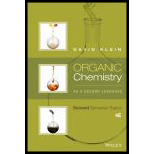
Concept explainers
And now, for a challenging problem, try to draw the mechanism of a desulfonation reaction (a reaction where we take the SO3H group off of the ring). The process will be exactly the reverse of what you just drew in the previous problem. There will be three steps: (1) remove the proton from the SO3H group, (2) H+ comes on the ring, and then (3) SO3 comes off of the ring. The truth is that there are only two core steps here: H+ comes on the ring, and then SO3 comes off of the ring. You can actually pull the proton off of the SO3H group at the same time that SO3 comes off of the ring. Try to do it yourself, and if you get stuck, you can look at the answer in the back of the book. Make sure that your mechanism involves an intermediate sigma complex (with a resonance-stabilized positive charge).
Want to see the full answer?
Check out a sample textbook solution
Chapter 4 Solutions
Organic Chemistry As a Second Language: Second Semester Topics
Additional Science Textbook Solutions
General Chemistry: Principles and Modern Applications (11th Edition)
Chemistry: The Central Science (13th Edition)
Chemistry: An Introduction to General, Organic, and Biological Chemistry (13th Edition)
Chemistry & Chemical Reactivity
Chemistry: A Molecular Approach
Fundamentals of Heat and Mass Transfer
- Draw a mechanism for this reaction. H₂C- CH3 -0- Interactive 3D display mode -CH3 H₂C CH₁₂ H₂C-O i Edit the reaction by drawing all steps in the appropriate boxes and connecting them with reaction arrows. Add charges where needed. Electron flow arrows should start on an atom or a bond and should end on an atom, bond, or location where a new bond should be created.arrow_forwardBr CH2 HBr CH3 Draw curved arrows to show the movement of electrons in this step of the reaction mechanism. Arrow-pushing Instructions CH2 Н— Br:arrow_forwardDraw the simplest mechanism possible for the reaction below. You may need to re-draw structures to show bond lines or lone pairs. Note to advanced students: There may be more than one resonance structure for one of your products. Make sure the mechanism you draw creates the resonance structure that's shown. HO. + + H₂O но HO + H₂Oarrow_forward
- Construct a three-step synthesis of 1-bromopropane from propane by dragging the appropriate formulas into the bins. Note that each bin willl hold only one item, and not all of the given reagents or structures will be used. Reactant Reagent 1 Step 1 Product Reagent 2 Step 2 Product Reagent 3 Final Product (1-bromopropane) (propane) Br2 Br2 (CH)3CO K HBr ROOR HBr NBS ROOR HaC Нас Нас, Нас Нас НаС. hv CH2 CH2 CH Нс CH-Br CH-Br CH Нас Нас, нC Нас НаС Br Br Brarrow_forwardMECHANISM ACTIVITY Base-Induced Ester Hydrolysis (Saponification) NOC XT Step 1: Nucleophilic addition of hydroxide ion to the ester carbonyl group Ahrs MPR R16 H3C. R Part A (1 of 2) Draw the curved arrows for Step 1 of this mechanism. Arrow-pushing Instructions CH3 H-O: ÖH OR' :Ö H-O: O: H H H H 1x xxx CH3 CH3 Step 1 H3C. CH3 заarrow_forwardFor each of the molecules below, identify whether the alkene has E or Z configuration. Molecule F H H • E or Z? OE Z ΟΕ ΟΖ Molecule F LL CN ОН NH₂ E or Z? OZ ΟΕ OZarrow_forward
- In the reaction series below, write down the appropriate reagents that can be used where there are question marks.arrow_forwardDraw the orgamic molecule(s) which is(are) formed in the following reaction. Do not include molecules like H,O or HCI. (You have 2 chances until the answer will be given; you have already tried 0 times) CH3 Сн он H,C H РСС CH CH, H,arrow_forwardWhich sequence of reactions will complete the transformation below? 1) BH3-THF, 2) NaOH, HOOH, 3) NaOEt 1) HBr, 2) ethanol, heat 1) BH3-THF, 2) HOOH, NaOH, 3) NaH (strong base), 4) ethyl iodide 1) HBr, ROOR, heat, 2) NaOEt OHBr, ethanol, heat LOCH₂CH3arrow_forward
- Draw one product of an elimination reaction between the molecules below. Note: There may be several correct answers. You only need to draw one of them. You do not need to draw any of the side products of the reaction. NH₂ Br. + × 5 Click and drag to start drawing a structure.arrow_forwardI do not understand the first two. I have not seen the reactants used in Q2 before, and for Q1 I thought it would result in elimination.arrow_forwardThis question has multiple parts. Work all the parts to get the most points. For the reaction below identify the reactant electrophile and the nudeophile. HO :OHarrow_forward
 ChemistryChemistryISBN:9781305957404Author:Steven S. Zumdahl, Susan A. Zumdahl, Donald J. DeCostePublisher:Cengage Learning
ChemistryChemistryISBN:9781305957404Author:Steven S. Zumdahl, Susan A. Zumdahl, Donald J. DeCostePublisher:Cengage Learning ChemistryChemistryISBN:9781259911156Author:Raymond Chang Dr., Jason Overby ProfessorPublisher:McGraw-Hill Education
ChemistryChemistryISBN:9781259911156Author:Raymond Chang Dr., Jason Overby ProfessorPublisher:McGraw-Hill Education Principles of Instrumental AnalysisChemistryISBN:9781305577213Author:Douglas A. Skoog, F. James Holler, Stanley R. CrouchPublisher:Cengage Learning
Principles of Instrumental AnalysisChemistryISBN:9781305577213Author:Douglas A. Skoog, F. James Holler, Stanley R. CrouchPublisher:Cengage Learning Organic ChemistryChemistryISBN:9780078021558Author:Janice Gorzynski Smith Dr.Publisher:McGraw-Hill Education
Organic ChemistryChemistryISBN:9780078021558Author:Janice Gorzynski Smith Dr.Publisher:McGraw-Hill Education Chemistry: Principles and ReactionsChemistryISBN:9781305079373Author:William L. Masterton, Cecile N. HurleyPublisher:Cengage Learning
Chemistry: Principles and ReactionsChemistryISBN:9781305079373Author:William L. Masterton, Cecile N. HurleyPublisher:Cengage Learning Elementary Principles of Chemical Processes, Bind...ChemistryISBN:9781118431221Author:Richard M. Felder, Ronald W. Rousseau, Lisa G. BullardPublisher:WILEY
Elementary Principles of Chemical Processes, Bind...ChemistryISBN:9781118431221Author:Richard M. Felder, Ronald W. Rousseau, Lisa G. BullardPublisher:WILEY





